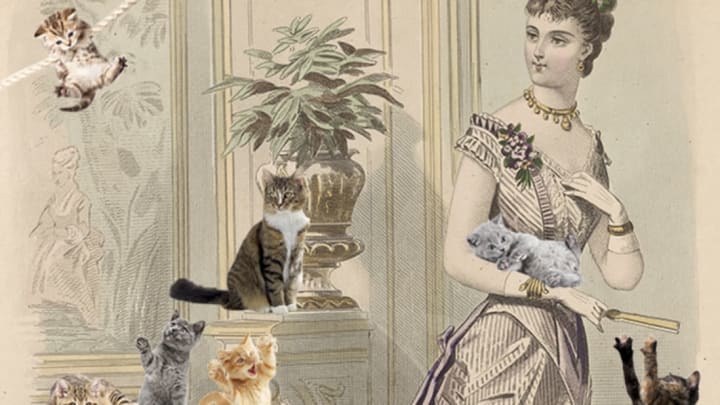You might think that the crazy cat lady is a modern concept, but according to an editorial called "Cats and Craziness," published in the August 11, 1872 issue of the New York Times, they were around even in the 19th century, with cases of an "insane man or woman who lives in a garrett, in the intimate society of three or four score cats ... perpetually coming to the knowledge of the public." The editoral goes on to describe what, exactly, a crazy cat person is, and it's highly entertaining—even if it is a little insulting to ailurophiles.
The "crazy lover of cats" was typically wealthy and "regards his attachment as a guilty one ... one which is to be kept, if possible, from the knowledge of his human neighbors ... It is only when his corpse is discovered by riotous cats, evidently bent upon 'waking' him after the most approved feline fashion, that his curious infatuation becomes known."
After these well-off lunatics die, they will, according to the editorial, often leave their money in a trust to care for their beloved felines. One man, living in Ohio, "not only provided luxurious lodging and feeding of his beloved associates, but ... insured ... a constant supply of healthy and attractive amusement for them":
He instructed his executors to prepare a large quantity of rat-holes in his Feline Retreat, and to stock them with a lavish supply of vigorous rats of the breed best adapted for the pleasures of the chase. He was also careful to secure for his cats abundant opportunity for the cultivation of their musical abilities ... It is a little remarkable that he omitted to provide them with an unlimited supply of free catnip and gratuitous valerian. It is possible, however, that he looked upon the use of these weeds as a form of feline dissipation which he could not encourage with any proper regard for the morals or health of young and thoughtless cats.
But just why do lunatics love cats so much, as opposed to, say, dogs? The editorial reasons that "there is evidently a bond of union between the lunatic and the cat which does not exist between sane persons and that undesirable animal. Possibly this bond consists in the fact that in most cases the lunatic develops a stealthy, tortuous cunning which assimilates him in some degree to the cat."
The Times writers clearly thought this cat-loving trend was very troubling, concluding, "the student of lunacy might well occupy his time in investigating the cause of this curious and frequent feature of insanity." You can read the whole thing here.
